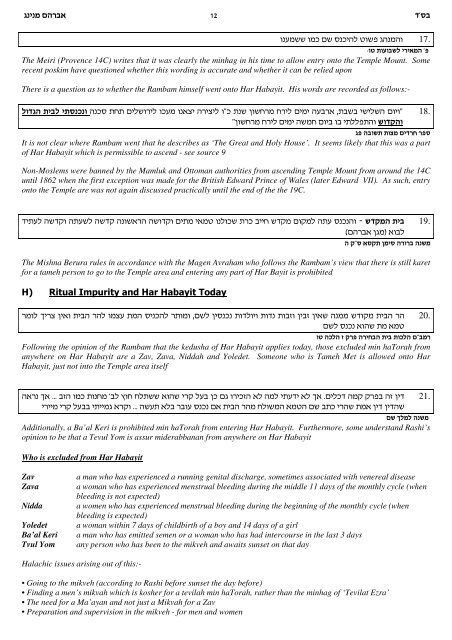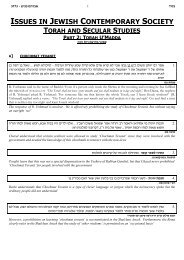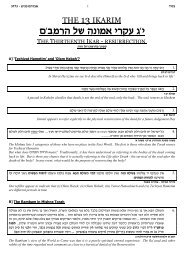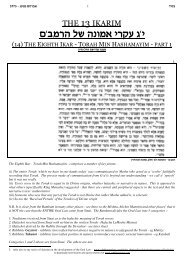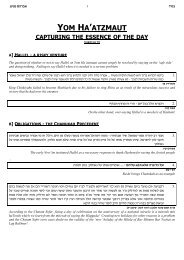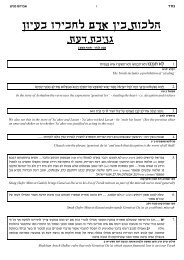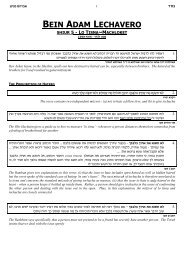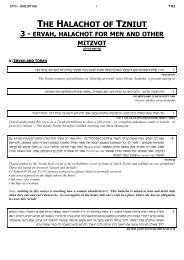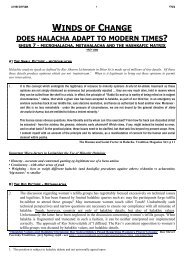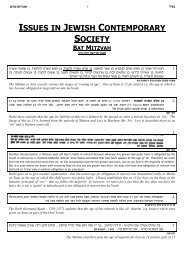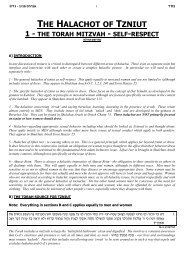Going Up To Har Habayit - Rabbi Anthony Manning
Going Up To Har Habayit - Rabbi Anthony Manning
Going Up To Har Habayit - Rabbi Anthony Manning
Create successful ePaper yourself
Turn your PDF publications into a flip-book with our unique Google optimized e-Paper software.
dbhbn ovrct<br />
12<br />
ubgnaa unf oa xbfhvk yuap dvbnvu 17.<br />
:uy ,ugucak hrhtnv �p<br />
The Meiri (Provence 14C) writes that it was clearly the minhag in his time to allow entry onto the Temple Mount. Some<br />
recent poskim have questioned whether this wording is accurate and whether it can be relied upon<br />
There is a question as to whether the Rambam himself went onto <strong>Har</strong> <strong>Habayit</strong>. His words are recorded as follows:-<br />
kusdv ,hck h,xbfbu vbfx ,j, ohkaurhk ufgn ubtmh vrhmhk u"f ,ba iuajrn jrhk ohnh vgcrt ',cac hahkav ouhu� 18.<br />
"iuajrn jrhk ohnh vanj ouhc uc h,kkp,vu ausevu<br />
dp vcua, ,umn ohsrj rpx<br />
It is not clear where Rambam went that he describes as ‘The Great and Holy House’. It seems likely that this was a part<br />
of <strong>Har</strong> <strong>Habayit</strong> which is permissible to ascend - see source 9<br />
Non-Moslems were banned by the Mamluk and Ottoman authorities from ascending Temple Mount from around the 14C<br />
until 1862 when the first exception was made for the British Edward Prince of Wales (later Edward VII). As such, entry<br />
onto the Temple are was not again discussed practically until the end of the the 19C.<br />
sh,gk vaseu v,gak vase vbuatrv vauseu oh,n htny ubkufa ,rf chhj asen ouenk v,g xbfbvu asenv ,hc 19.<br />
(ovrct idn) tuck<br />
v e"x txe, inhx vrurc vban<br />
The Mishna Berura rules in accordance with the Magen Avraham who follows the Rambam’s view that there is still karet<br />
for a tameh person to go to the Temple area and entering any part of <strong>Har</strong> Bayit is prohibited<br />
H) Ritual Impurity and <strong>Har</strong> <strong>Habayit</strong> <strong>To</strong>day<br />
rnuk lhrm ihtu ,hcv rvk unmg ,nv xhbfvk r,unu 'oak ihxbfb ,uskuhu ,usb ,uczu ihcz ihta vbnn asuen ,hcv rv 20.<br />
oak xbfb tuva ,n tny<br />
uy vfkv z erp vrhjcv ,hc ,ufkv o"cnr<br />
Following the opinion of the Rambam that the kedusha of <strong>Har</strong> <strong>Habayit</strong> applies today, those excluded min ha<strong>To</strong>rah from<br />
anywhere on <strong>Har</strong> <strong>Habayit</strong> are a Zav, Zava, Niddah and Yoledet. Someone who is Tameh Met is allowed onto <strong>Har</strong><br />
<strong>Habayit</strong>, just not into the Temple area itself<br />
vtrb lt /// czv unf ,ubjn �ck .uj jk,aa tuva hre kgc if od urhfzv tk vnk h,gsh tk lt /ohkfs vne erpc vz ihs 21.<br />
hrhhn hre kgcc h,hhnd treu /// vag, tkc rcug xbfb ot ,hcv rvn jkuanv tnyv oa c,f hrva ,nt ihs ihsva<br />
oa lknk vban<br />
Additionally, a Ba’al Keri is prohibited min ha<strong>To</strong>rah from entering <strong>Har</strong> <strong>Habayit</strong>. Furthermore, some understand Rashi’s<br />
opinion to be that a Tevul Yom is assur miderabbanan from anywhere on <strong>Har</strong> <strong>Habayit</strong><br />
Who is excluded from <strong>Har</strong> <strong>Habayit</strong><br />
Zav a man who has experienced a running genital discharge, sometimes associated with venereal disease<br />
Zava a woman who has experienced menstrual bleeding during the middle 11 days of the monthly cycle (when<br />
bleeding is not expected)<br />
Nidda a women who has experienced menstrual bleeding during the beginning of the monthly cycle (when<br />
bleeding is expected)<br />
Yoledet a woman within 7 days of childbirth of a boy and 14 days of a girl<br />
Ba’al Keri a man who has emitted semen or a woman who has had intercourse in the last 3 days<br />
Tvul Yom any person who has been to the mikveh and awaits sunset on that day<br />
Halachic issues arising out of this:-<br />
• <strong>Going</strong> to the mikveh (according to Rashi before sunset the day before)<br />
• Finding a men’s mikvah which is kosher for a tevilah min ha<strong>To</strong>rah, rather than the minhag of ‘Tevilat Ezra’<br />
• The need for a Ma’ayan and not just a Mikvah for a Zav<br />
• Preparation and supervision in the mikveh - for men and women<br />
-<br />
s�xc


